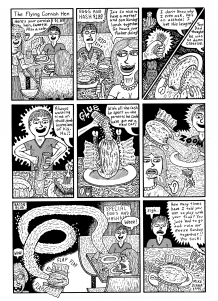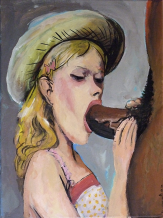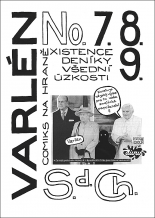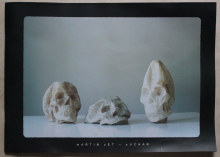| Umělec magazine 1998/5 >> A Holiday Visit or Frustration? (Supermarket Merchandise as Museum Art) | List of all editions. | ||||||||||||
|
|||||||||||||
A Holiday Visit or Frustration? (Supermarket Merchandise as Museum Art)Umělec magazine 1998/501.05.1998 Tomáš Pospiszyl | analysis | en cs |
|||||||||||||
|
"“I’m all lost in the supermarket, I can no longer shop happily...“, sings the British punk band The Clash. Although it is one of my favorite songs, I started to understand its atmosphere and text better only in recent years. Before 1989, it was indeed difficult to get lost in a store full of goods. Now it is no longer so difficult. Getting lost in a supermarket comes about in a moment when we for some reason interrupt our shopping and try to get out. We find out that it is difficult to find our way if we are not shopping. If we keep on undisturbed shopping, we will walk through the entire store and ultimately end up by the cash registers. Supermarkets are designed exclusively for shopping. If we are not shopping in them, we are lost not only in fact but also in transposition. There is no space for non-shoppers in a supermarket; it is not designed for them. Non-shoppers then necessarily have to give in to existential anxiety.
The Černý Most shopping mall is said to be the largest in the Czech Republic and perhaps in Central Europe. The most attractive thing about this whole complex, I think, is not the actual size of it but the fact that it is so isolated. The journey to Černý Most takes a long time and current underground construction will not shorten it up. Stuffed between a housing complex and a highway, the mall is located in a perfect no-man’s land. We can walk into the little shops downtown just like that, if we are attracted by something in the window as we are passing by. To get out to the Černý Most shopping mall, we have to do so intentionally; it cannot happen that we just happen to go by and are lured inside. Nobody is just walking past the Černý Most mall. Its exterior corresponds with this fact and, in contrast to the decorated shops downtown, from afar the mall looks like a factory lacking windows with ramps for trucks and a large parking lot. If we decide to go up there, we have to spare a whole afternoon for such a visit. Černý Most’s architecture, similar to other shopping malls abroad, is completely interior architecture. We have no idea what awaits us inside (some movie theaters are similarly mysterious). Once inside, we do not perceive the walls or the ceiling, which is often full of ugly air-conditioning tubes and various piping, but we fully concentrate on the wares displayed around us. The layout of the racks and other lures prohibits estimation of the entire area of the mall. We mainly make our way systematically from one type of goods to the next without having an idea of the mall’s entirety and its potential dominant features and important places. The goods in the mall are displayed in a democratic manner; not one single type of merchandise holds more importance for the visitor than another. If a visitor arrives at the mall with an exact idea of what to buy, the store’s layout makes this plan very difficult. The shoppers unnecessarily go from one kind of goods to the next. Compared to counter sales in classic shops, where we ask the attendant for the exact item we are interested in and need, in a supermarket we are overwhelmed with thousands of other goods that we usually don’t even want. An experienced supermarket visitor, however, manages to find his way through such stores and tap into a certain system according to which the stock is displayed. Even though various supermarkets are owned by different companies, their setup and choice of products shows many a similar feature. Žižkov’s Pronto market and Delvita in Dejvice quite surprisingly begin with drugstore goods and crackers, which then flow into the vegetable department. Since the entrance into these two stores is right by the cash registers, we see that the supermarket ends with the drugstore if we go from the end towards the cash registers. In Černý Most, foodstuffs share one large space with electronics and clothing. The transition to food is mediated by a bumper area of kitchen supplies and plastic items. Right after that comes the bread. I don’t know of any supermarket that would start with meat or milk products - at Kotva, however, milk and milk products come second. I’ve also never seen a supermarket that would start with alcohol or pasta. Further combinations can be observed in the placement of the individual products and brands. Yogurt and milk products are often placed in the same group with frozen products, i.e., ice cream and frozen vegetables. Sometimes ice cream is placed closer to the exit and frozen vegetables may form their own department together with frozen fish and meat. Matched with sweets is usually wine (never pasta or rice). Perhaps it’s a coincidence that instant soups are never far from beer. The logic of a supermarket’s layout is derived from the operational possibilities; i.e. foodstuffs that need freezers are all grouped together. Tradition and the supermarket management’s habits also represent an important factor. Most of the established supermarkets went through radical changes at the beginning of the 90‘s when the market was flooded with new products of different, competing companies. The supermarket’s interior had to be adapted to the new conditions. The struggle between the two coffee brands of Tchibo and Douwe Egberts resulted in the unusual expansion of the coffee department. Different kinds of food in supermarkets are placed according to their similarity but this principle is often subject to change. Juices are usually located in a place separate from other non-alcoholic drinks - often by the vegetables. The product’s origin and pedigree is perhaps more important than its classification as a non-alcoholic beverage. Instant soups and spices are connected perhaps by their loose state but flour is excluded from this community. The decisive factor may be that both soups and spices are eventually dissolved (in water, sauces) into the form of the final meal. Kool-Aid doesn’t belong here, as it is sweet. Since no supermarket comprises one simple long hallway starting with an entrance and ending with cash registers, and since supermarkets are usually wide, with individual shelves forming sort of parallel aisles ranging from two to, say, seven, there are a number of possibilities for arranging the merchandise. Certain combinations, however, remain the same. Taking into consideration a supermarket with one central shelf, it is organized according to the following classic setup: (please see Table 1) Description: P - cash registers, Z - vegetables, M - milk and milk products, Zm - ice-cream, N - non-alcoholic beverages, Pi - beer, V - wine and spirits, D - drugstore, L - deli department, Ma - meat products, Mr - frozen goods (vegetables, fish), T - pasta, Ch - bread, K - canned food, S - sweets, Po - soups and spices. There may naturally be deviations from the norm sometimes; please see Table 2 for a number of local variations on similar schemes. The Modern Art Museum in New York also understands its permanent exhibition as a fixed area not to be often altered. This rigidity of succession is similar to the set structure of the ideal supermarket. A customer is accustomed subconsciously to expect certain things in certain places and changes of products cannot be done all at ones using radical alterations of interior layout but through gradual changes and implementing new elements to the existing structure. In the Czech Republic, we are both seeking the ideal setup of a supermarket and debating the futures of local museums of contemporary and modern art. The order and structure of both institutions, i.e., the supermarket and the contemporary art museum, are more popular than chaos of fortuity and the visitor clearly understands the institution’s meaning. Thanks to skillful combinations and element transition, visitors to a supermarket buy as many products as possible and visitors to a museum understood the fundamentals of modern and contemporary art. These combinations allow us to contemplate individual products and artworks in the contexts that the creators of the museum and the supermarket consider correct and effective, despite the fact that they may come from completely different environments and eras. This analogy game that ignites an imaginative reaction in the visitor’s brain (cubist art, dinner) is exactly what the creators aim for. In a supermarket, our contemplation is also inspired by music (compare the Master Theodoricus exhibition at the St. Agnes Monastery). In contrast to the supermarket, at the museum you pay in advance. In supermarkets, you pay when you leave and if you don’t choose any product, you don’t have to pay at all. Both supermarket and museum creators aim to induce you to walk through the entire space even though this sometimes requires a lot of physical activity and a lot of time (Černý Most Mall, Veletržní palác - Modern and Contemporary Art Collection). The paths are carefully selected so that the visitors do not miss any sections but can avoid those they choose to. When a facility reaches a certain size, it is necessary to equip it with refreshments and resting areas (MoMA, Černý Most Mall). Large museums, like large shopping malls, require that we intentionally plan our visits. To find our way through, we are assisted by an orientation system that marks the individual sections either by colors or words. In both museums and supermarkets, guards make sure that general rules are followed. Visiting foreign modern and contemporary art museums and supermarkets, we find out that their stuctures are similar despite local specialities and various packaging. Some international companies’ products and certain artists can be found in similar institutions all over the world. Compared to supermarkets with their range of possible structural arrangements, museums and their permanent collections seem to be organized purely on a chronological basis. With new so-called postmodern ideologies, however, this method is under the ever-fiercer fire of criticism, and alternative permanent expositions are emerging which exhibit works from different periods in one group. Furthermore, the strict chronological method is not conducive to fully capturing the character of the individual artists who, if active for several decades, could potentially go through various creative phases. In addition to classic chronological expositions, we also find exhibitions that only work with a certain area of art (landscape) or with those that represent artists from one geographical area (Spain). At the same time we witness museums’ expansion into new disciplines such as film or fashion juxtaposed with classic art. Naturally, museums and supermarkets are not identical due to their different subject foci. A museum presents unique cultural objects, a supermarket sells food. Both benefit their visitors but remain very different. Despite their differences, however, it is their organizational and spatial stucture, problems and possibilities of their arrangement that reveal a remarkable number of related elements. The feeling of being ”lost in the supermarket,” as quoted in the Clash song, may and certainly does occur with many museum visitors. We, however, visit supermarkets more often, and thus the feeling of estrangement occurs more often. If a museum visitor stops to perceive what the creators of the exhibition are trying to say and does not understand exhibited art or is not interested in the type of art exhibited, he will give in not only to boredom but also to the feeling of being lost in machinery he cannot control, upon whose end he may only speculate. The question is whether there a museum alternative of ”over-the-counter-sales” exists as it does in the supermarket. Excluding electronic media and book reproductions, alternative mediation of authentic art values is not going to be as easy as introducing new foodstuffs on the market. One of the ways to avoid the supermarketization of museums is to create permanent installations of contemporary art in public spaces, or to create networks of smaller, specialized museums (a permanent exhibition of a certain artist, permanent exhibitions of defined art styles, theme exhibitions). It is bad luck that the Czech Republic has only recently created the conditions for a truly representative supermarket of modern and contemporary art. Foreign know-how may therefore prove useful, but in the end the determining factors are the capacity of local goods, the purchasing power of local consumers and the ability to attract the interest of foreign visitors. Visiting the Černý Most Mall, we realize the complexity of the task faced by the creators of such large supermarkets. Some of their decisions influence the quantity of individual product sales as well as the display of the merchandise. Furthermore, the supermarket design must include elements and solutions that will prevent visitors immediately from feeling lost and make their shopping experience free of boredom and monotony. The situation of the Černý Most designers was more difficult, because they had to combine a supermarket with an electronics and clothing store. The transition from one department to another is not always smooth, but simultaneously makes the overall impression more refreshing than might be the case with a slow and inconspicuous transition. In our local conditions, there is not enough experience with such large spaces and therefore the mall looks unpleasantly vast, hence frustrating, from the beginning. As I push my cart along colorful shelves and evaluate the fish counter from afar, pick vegetables and have them weighed, when I am amazed by the number of brands and kinds of yogurts, when I explore the content of the freezers before opening their lids to fish out green peas and broccoli in clouds of steam, I feel as if I am in an amusement park or - as I previously suggested - in an art gallery or museum. My advance from one product to the next, visually evaluating each, stopping at those that intrigue me, is nearly identical to my movement in a museum. The packaging and arrangement of some products does not lack aesthetic qualities. Since producers try to make their products as striking as possible, supermarkets represent an attack on the shopper’s perception as the shopper absorbs hundreds of various objects in all possible color combinations. A supermarket can be very stimulating place, and many artists can find inspiration there. Supermarket appear in diverse contexts in the works of Guillaume Bijl, Gabriel Orozco and Kryštof Kintera. I believe that the vast and complex, yet fascinating, Louvre collections from various periods offered similar inspiration to artists in the past. Given the reasons explained above, shopping in Černý Most is not an insignificant experience. If we approach it with a certain sensitivity, it may become a holiday event akin to visiting a museum. "
01.05.1998
Recommended articles
|
|||||||||||||
|
04.02.2020 10:17
Letošní 50. ročník Art Basel přilákal celkem 93 000 návštěvníků a sběratelů z 80 zemí světa. 290 prémiových galerií představilo umělecká díla od počátku 20. století až po současnost. Hlavní sektor přehlídky, tradičně v prvním patře výstavního prostoru, představil 232 předních galerií z celého světa nabízející umění nejvyšší kvality. Veletrh ukázal vzestupný trend prodeje prostřednictvím galerií jak soukromým sbírkám, tak i institucím. Kromě hlavního veletrhu stály za návštěvu i ty přidružené: Volta, Liste a Photo Basel, k tomu doprovodné programy a výstavy v místních institucích, které kvalitou daleko přesahují hranice města tj. Kunsthalle Basel, Kunstmuseum, Tinguely muzeum nebo Fondation Beyeler.
|










































 We Are Rising National Gallery For You! Go to Kyjov by Krásná Lípa no.37.
We Are Rising National Gallery For You! Go to Kyjov by Krásná Lípa no.37.
Comments
There are currently no comments.Add new comment